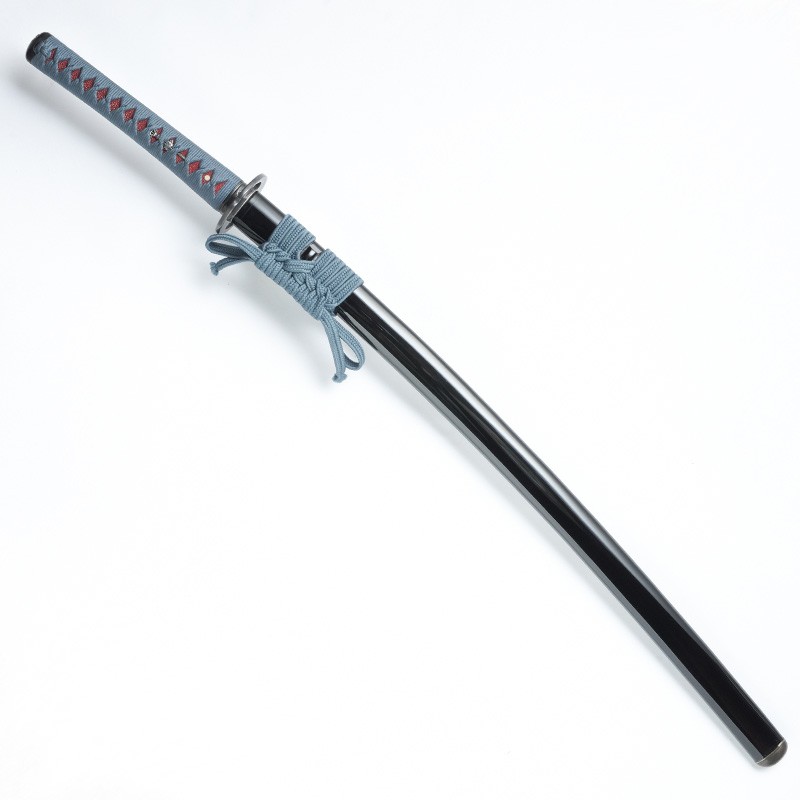














More informations about this product
The Hon Higo Koshirae 本肥後拵 is a montage that highlights a Higo montage, with a flamboyant appearance.
This model is a variant of the Higo Koshirae 肥後 mounts, in a finish that is 'superior' 本 (Hon). This type of assembly was created from swords of Hosokawa Tadaoki (1563-1646), Lord of the ancient province of Higo, now Kumamoto, on the island of Kyushu. An experienced swordsman, Hosokawa Tadaoki also excelled in poetry, painting, and particularly in the art of the tea ceremony. Rallying the power of the sword to the refinement of the arts of tea, he was an artist, expert and aesthete confirmed.
There are all the peculiarities and elegance of the Higo swords, a curved Tsuka (concave), making it easy to grip, as well as a rounded kashira and Kojiri in iron.
On the Fuchi and Kashira, the leaf pattern of Ginkgo 銀杏 is inlaid with silver 'Gin Zogan' 銀象. Ginkgo is a symbol of growth, prosperity and longevity. The Kanji 'Ginkgo' can be read 'silver apricot' (銀 Silver; 杏 Apricot). It is one of the oldest trees in the world, and the oldest known specimen, located in Sendai (Japan), displays 1250 years of age. They are worshipped as sacred trees in Shinto shrines.
The Menuki with the motifs of Ken Tachibana 剣橘 represent a branch of Mandarinier crossed by a Sankozuka Ken 三鈷柄剣. The Sankozuka Ken is a double-edged Buddhist sword for rituals. With the resistance of the diamond and the power of lightning, it would drive out demons. It is also the sword of the deity Fudo-Myo 不動明王.
The Tachibana, tangerine, is like the Ginkgo a species from China and introduced in Japan 2000 years ago. Referring to a very ancient Japanese aristocratic lineage of the Nara period, it is one of the most used heraldic symbols in Japan. Tachibana is therefore a symbol of longevity and traditions. It is said that the taste of tangerine makes nostalgic of ancient times.
The blade type for this fixture is a light (standard) blade, approximately 820g.
Nagasa length possible from 2.20尺 (66.6cm) to 2.55尺 (77.3cm).
size charts (see attached table of recommended sizes)
Hamon: Suguha (straight line).
Habaki: Shonai (old-fashioned design), made of brass.
Tsuba: Iron Kagechō 影蝶 (butterfly shadow).
Fuchi/ Kashira: Kashira rounded type Higo, genuine copper parts blackened. Silver inlay (Zogan) with gold Ginkgo 銀杏 (Ginkgo zogan), Seppa design.
Same: Stingray (Roussette or Raie), Vermilion Red color.
Menuki: Ken Tachibana 剣橘, Tsurugi-style double-edged sword with a branch of Mandarin.
Tsukaito: Hineri Maki blue steel cotton handle braiding.
Sageo: Blue steel cotton.
Saya: Hon Kuroro, glossy black lacquer, with golden Shitodome and Kojiri Rounded in blackened iron.
The Minosaka Workshops :
The Iaito we offer come from Minosaka workshops in Gifu, Japan, and are manufactured in their workshop in Japan.
Gifu is one of the top places known for the forging of traditional sabres, including the Mino tradition, dating from the 14th century. Minosaka workshops are Iaito’s leading producers of tradition.
This traditional workshop manufactures its chrome-plated Zamak Iaito (Zinc and Aluminum alloy with some Copper) which is stainless.
This non-ferrous alloy makes the Iaito blunt and unsharpenable:
They are practical tools for Kata, without contact between the blades.
Share your opinion
error Your review appreciation cannot be sent
feedback Report comment
check_circle Report sent
error Your report cannot be sent